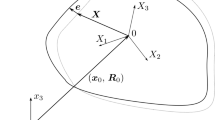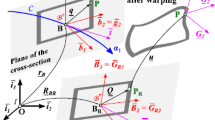Abstract
In this paper, an approach named Motion Analysis of Structures (MAS) is introduced to analyze planar motion of solids. The theoretical basis of MAS is constructed on vector mechanics instead of analytical mechanics. Four procedures are involved to embody this approach. Namely, (a) discretization of structure, (b) discretization of particle path, (c) evaluation of deformations and internal forces, and (d) time integration. The first three procedures are not involved in solving the governing equations of continuum, instead directly formulating the equations of motion of a particle set via Newton’s law. Therefore, MAS is a particle approach. In procedure (c), the vector form intrinsic finite element (VFIFE) is employed, where a description of kinematics to dissect rigid body motion and deformation, a set of deformation coordinates for each time increment to describe element deformation, and the convected material frame solution procedure are included. The algorithms of coupling with rigid bodies and modeling of constraints are presented as well. Numerical examples for large rotation and benchmark verifications are performed to demonstrate the capability and accuracy of the approach in analysis of multibody system dynamics.
Similar content being viewed by others
References
Belytschko, T., Hsieh, B.J.: Nonlinear transient finite element analysis with convected coordinates. Int. J. Numer. Methods Eng. 7, 255–271 (1973)
Bathe, K.J., Ramm, E., Wilson, E.L.: Finite element formulations for large deformation dynamic analysis. Int. J. Numer. Methods Eng. 9, 353–386 (1975)
Bathe, K.J.: Finite Element Procedures. Prentice-Hall, New York (1996)
Crisfield, M.A., Moita, G.F.: A co-rotational formulation for 2-D continua including incompatible modes. Int. J. Numer. Methods Eng. 39, 2619–2633 (1996)
Gerstmayr, J., Schöberl, J.: A 3D finite element method for flexible multibody systems. Multibody Syst. Dyn. 15, 309–324 (2006)
Kane, T.R., Levinson, D.A.: Dynamics: theory and applications. McGraw-Hill, New York (1985)
Shabana, A.A.: Flexible multibody dynamics: review of past and recent developments. Multibody Sys. Dyn. 1, 189–222 (1997)
Shabana, A.A.: Dynamics of Multibody Systems, 2nd edn. Wiley, New York (1998)
Shabana, A.A., Christensen, A.P.: Three-dimensional absolute nodal co-ordinate formulation: plate problem. Int. J. Numer. Methods Eng. 40, 2775–2790 (1997)
Shi, C., Wang, Y.K., Ting, E.C.: Fundamentals of a vector form intrinsic finite element: Part III. Convected material frame and examples. J. Mech. 20, 133–143 (2004)
Song, J.O., Haug, E.J.: Dynamic analysis of planar flexible mechanism. Comput. Methods Appl. Mech. Eng. 24, 359–381 (1980)
Ting, E.C., Shi, C., Wang, Y.K.: Fundamentals of a vector form intrinsic finite element: Part I. Basic procedure and a planar frame element. J. Mech. 20, 113–122 (2004)
Ting, E.C., Shi, C., Wang, Y.K.: Fundamentals of a vector form intrinsic finite element: Part II. Plane solid element. J. Mech. 20, 123–132 (2004)
Ting, E.C., Wang, C.Y., Wu, T.Y., Wang, R.Z., Chuang, C.C.: Motion analysis and vector form intrinsic finite element. Report No. CBER-2006-W-001, V-5 Research Group, National Central University, Taiwan (2006)
Wasfy, T.M., Noor, A.K.: Computational strategies for flexible multibody systems. Appl. Mech. Rev. 56, 553–613 (2003)
Wu, T.Y., Wang, R.Z., Wang, C.Y.: Large deflection analysis of flexible planar frame. J. Chin. Inst. Eng. 29, 593–606 (2006)
Wu, T.Y., Wu, J.H., Ho, J.M., Chuang, C.C., Wang, R.Z., Wang, C.Y.: A study on motion analysis of 3D solids by a vector form intrinsic finite element. J. Chin. Inst. Civ. Hydraul. Eng. 19, 79–89 (2007) (in Chinese)
Wu, T.Y., Wang, C.Y., Chuang, C.C., Ting, E.C.: Motion analysis of 3D membrane structures by a vector form intrinsic finite element. J. Chin. Inst. Eng. 30, 961–976 (2007)
Wu, T.Y., Ting, E.C.: Large deflection analysis of 3D membrane structures by a 4-node quadrilateral intrinsic element. Thin-Walled Struct. 46, 261–275 (2008)
Author information
Authors and Affiliations
Corresponding author
Rights and permissions
About this article
Cite this article
Wu, TY., Lee, JJ. & Ting, E.C. Motion analysis of structures (MAS) for flexible multibody systems: planar motion of solids. Multibody Syst Dyn 20, 197–221 (2008). https://doi.org/10.1007/s11044-008-9108-4
Received:
Accepted:
Published:
Issue Date:
DOI: https://doi.org/10.1007/s11044-008-9108-4




